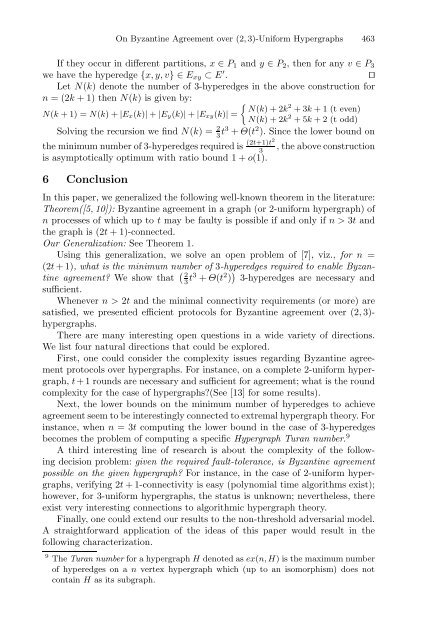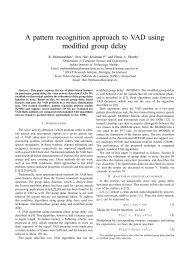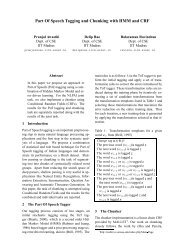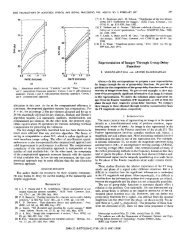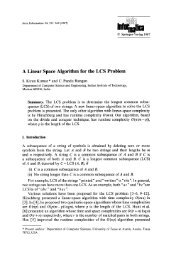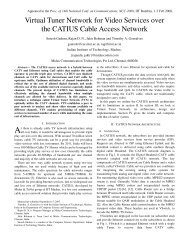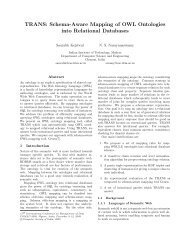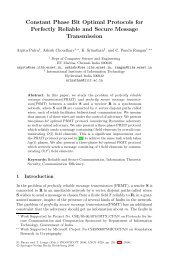On Byzantine Agreement over (2,3)-Uniform ... - Cornell University
On Byzantine Agreement over (2,3)-Uniform ... - Cornell University
On Byzantine Agreement over (2,3)-Uniform ... - Cornell University
Create successful ePaper yourself
Turn your PDF publications into a flip-book with our unique Google optimized e-Paper software.
<strong>On</strong> <strong>Byzantine</strong> <strong>Agreement</strong> <strong>over</strong> (2, 3)-<strong>Uniform</strong> Hypergraphs 463<br />
If they occur in different partitions, x ∈ P 1 and y ∈ P 2 , then for any v ∈ P 3<br />
we have the hyperedge {x, y, v} ∈E xy ⊂ E ′ .<br />
⊓⊔<br />
Let N(k) denote the number of 3-hyperedges in the above construction for<br />
n =(2k +1)thenN(k) isgivenby:<br />
{ N(k)+2k 2 +3k + 1 (t even)<br />
N(k +1)=N(k)+|E x(k)| + |E y(k)| + |E xy(k)| =<br />
N(k)+2k 2 +5k + 2 (t odd)<br />
Solving the recursion we find N(k) = 2 3 t3 + Θ(t 2 ). Since the lower bound on<br />
the minimum number of 3-hyperedges required is (2t+1)t2<br />
3<br />
, the above construction<br />
is asymptotically optimum with ratio bound 1 + o(1).<br />
6 Conclusion<br />
In this paper, we generalized the following well-known theorem in the literature:<br />
Theorem([5, 10]): <strong>Byzantine</strong> agreement in a graph (or 2-uniform hypergraph) of<br />
n processes of which up to t may be faulty is possible if and only if n>3t and<br />
the graph is (2t + 1)-connected.<br />
Our Generalization: See Theorem 1.<br />
Using this generalization, we solve an open problem of [7], viz., for n =<br />
(2t +1), what is the minimum number of 3-hyperedges required to enable <strong>Byzantine</strong><br />
agreement? We show that ( 2<br />
3 t3 + Θ(t 2 ) ) 3-hyperedges are necessary and<br />
sufficient.<br />
Whenever n>2t and the minimal connectivity requirements (or more) are<br />
satisfied, we presented efficient protocols for <strong>Byzantine</strong> agreement <strong>over</strong> (2, 3)-<br />
hypergraphs.<br />
There are many interesting open questions in a wide variety of directions.<br />
We list four natural directions that could be explored.<br />
First, one could consider the complexity issues regarding <strong>Byzantine</strong> agreement<br />
protocols <strong>over</strong> hypergraphs. For instance, on a complete 2-uniform hypergraph,<br />
t + 1 rounds are necessary and sufficient for agreement; what is the round<br />
complexity for the case of hypergraphs?(See [13] for some results).<br />
Next, the lower bounds on the minimum number of hyperedges to achieve<br />
agreement seem to be interestingly connected to extremal hypergraph theory. For<br />
instance, when n =3t computing the lower bound in the case of 3-hyperedges<br />
becomes the problem of computing a specific Hypergraph Turan number. 9<br />
A third interesting line of research is about the complexity of the following<br />
decision problem: given the required fault-tolerance, is <strong>Byzantine</strong> agreement<br />
possible on the given hypergraph? For instance, in the case of 2-uniform hypergraphs,<br />
verifying 2t + 1-connectivity is easy (polynomial time algorithms exist);<br />
however, for 3-uniform hypergraphs, the status is unknown; nevertheless, there<br />
exist very interesting connections to algorithmic hypergraph theory.<br />
Finally, one could extend our results to the non-threshold adversarial model.<br />
A straightforward application of the ideas of this paper would result in the<br />
following characterization.<br />
9 The Turan number for a hypergraph H denoted as ex(n, H) is the maximum number<br />
of hyperedges on a n vertex hypergraph which (up to an isomorphism) does not<br />
contain H as its subgraph.


